What Is Body Dysmorphic Disorder? A Deeper Look at the Mind-Body Connection
Introduction
n a world obsessed with appearance, it’s easy to have moments of insecurity — wishing your skin looked clearer, your nose smaller, your body leaner. But for people with Body Dysmorphic Disorder (BDD), those thoughts aren’t fleeting. They’re consuming.
BDD isn’t about vanity. It’s a serious mental health condition where a person becomes fixated on perceived flaws in their appearance — flaws that others may not even notice.
Underneath that fixation lies a deep neurological and emotional imbalance — one that ties together brain chemistry, self-image, trauma, and the body’s stress response.
This article takes a deeper look at BDD: what it is, how it forms, how it affects both the mind and body, and what emerging science says about healing this painful disconnect 🌿.
Looking for supplements for This? Click here.
Understanding Body Dysmorphic Disorder 🧩
Body Dysmorphic Disorder is classified under the obsessive-compulsive spectrum. That means it shares certain traits with OCD — repetitive thoughts and behaviors that spiral into anxiety and compulsive checking or reassurance-seeking.
Someone with BDD might spend hours each day inspecting their reflection, comparing themselves to others, or trying to “fix” perceived flaws through makeup, surgery, or constant self-evaluation.
But the issue isn’t the body itself. It’s the brain’s perception of the body.
Neuroimaging studies show that people with BDD process visual information differently — focusing on details rather than the whole picture. When they look in the mirror, they don’t see balance or proportion. They see distortion.
The result is a powerful emotional loop: distress about appearance triggers anxiety, which strengthens obsessive thoughts, which in turn reinforces distorted self-image.
The Emotional Core Beneath Appearance Issues ❤️🩹
On the surface, BDD looks like an obsession with looks. But underneath, it’s often about shame, rejection, and control.
Many people with BDD have histories of trauma, bullying, emotional neglect, or environments where self-worth was tied to appearance or achievement. The body becomes the battleground for emotions that feel too painful to process directly.
Instead of feeling “I’m unlovable,” the mind translates it to “My face is wrong,” or “My body is disgusting.”
These self-judgments are not rational — they’re emotional echoes stored in the nervous system. Healing, therefore, must go beyond surface reassurance. It must reach the mind-body interface where perception and emotion intertwine.
The Brain Chemistry of BDD 🧠

The neurobiology of Body Dysmorphic Disorder involves imbalances in neurotransmitters — especially serotonin, dopamine, and glutamate.
Serotonin, the “calm and balance” chemical, helps regulate mood and perception. Low serotonin can make the brain hyper-aware of perceived flaws.
Dopamine, which governs reward and attention, may amplify repetitive behaviors and fixations.
Glutamate, the main excitatory neurotransmitter, can overstimulate neural circuits, keeping the mind stuck in loops of self-scrutiny.
Brain imaging studies also reveal irregular activity in the frontostriatal circuits — regions responsible for decision-making, habit formation, and visual processing.
This means that BDD is not “all in your head” in a dismissive sense — it’s literally in the neural wiring that shapes how you see yourself.
The Stress Response and the Body 🌡️
Chronic body dissatisfaction keeps the body locked in fight-or-flight mode.
Every time you glance in the mirror and feel disgust or panic, your brain releases cortisol and adrenaline. Your heart rate increases. Muscles tense. The body prepares for danger — even though the “danger” is internal.
Over time, this constant stress disrupts sleep, digestion, and immune function. It also dulls the prefrontal cortex — the logical part of the brain that can see the bigger picture.
That’s why reassurance (“You look fine!”) rarely helps. The body doesn’t feel safe. The nervous system must be calmed before perception can change.
The Mind-Body Connection 🪞
The phrase “mind-body connection” is more than a cliché. It’s the biological reality that thoughts, emotions, and physical sensations exist in constant communication.
When someone with BDD thinks, I look awful, their body reacts as if something truly dangerous has occurred. The muscles tighten, breath shortens, and cortisol surges. The emotional brain (amygdala) floods the system, reinforcing fear-based attention.
But the connection works both ways. When the body relaxes — through deep breathing, grounding, or gentle movement — the brain receives signals of safety. Over time, this can retrain perception.
Healing from BDD involves rebuilding this relationship — learning to listen to the body not as an enemy, but as an ally.
Signs and Symptoms of BDD 🪞
BDD can look different for everyone, but common experiences include:
Persistent preoccupation with perceived defects in appearance
Spending hours checking mirrors or avoiding them altogether
Comparing appearance to others constantly
Repetitive grooming, skin-picking, or seeking reassurance
Social withdrawal due to shame or fear of judgment
Frequent thoughts of cosmetic surgery or dissatisfaction even after procedures
Many people with BDD know their perceptions are exaggerated, yet they can’t stop the thoughts. This internal conflict deepens distress and self-criticism.
The Role of Trauma in Body Dysmorphia 💔
While not everyone with BDD has a trauma history, many do. Emotional neglect, bullying, and early rejection experiences can wire the brain to associate safety with control — especially control over appearance.
Trauma also fragments self-image. The body can feel alien, untrustworthy, or wrong. This fragmentation makes it harder to integrate physical sensations and emotional awareness.
In this sense, BDD can be seen as the nervous system’s attempt to find certainty in the uncertain — by hyper-focusing on what can be seen (the body) instead of what’s felt (the emotion).
Healing requires integration — teaching the body it’s safe to exist as it is, and teaching the mind to perceive wholeness instead of flaw.
Supplements That May Support Emotional and Neural Balance 🌿
While supplements alone can’t treat BDD, certain nutrients may support brain chemistry and nervous system regulation when used alongside therapy.
Omega-3 Fatty Acids (EPA/DHA)
These essential fats improve neuron communication and reduce inflammation. Omega-3s are linked to improved mood, emotional resilience, and balanced perception — particularly helpful in conditions with obsessive features.
Magnesium Glycinate or Threonate
Magnesium supports GABA receptors, calms the nervous system, and reduces cortisol. It can help ease the tension and anxiety that often accompany body image spirals.
L-Theanine
This green-tea amino acid promotes relaxation and focus by increasing alpha brain waves. It helps you stay present in your body rather than dissociating into anxious thought loops.
B Vitamins (Especially B6, B9, and B12)
B vitamins regulate serotonin and dopamine synthesis. Chronic stress depletes them, so restoring levels can enhance mood and cognitive clarity.
Adaptogens (Ashwagandha, Rhodiola, or Holy Basil)
Adaptogens help balance the HPA axis — your body’s stress control center. They can reduce anxiety, improve focus, and support emotional steadiness during recovery.
Always consult a healthcare provider before starting supplements, especially if you take medications or have coexisting conditions.
Looking for supplements for This? Click here.
The Power of Breathwork and Grounding 🌬️
People with BDD often live in a state of hypervigilance — constantly scanning the body or environment for reassurance or threat.
Breathwork breaks that loop by activating the parasympathetic nervous system — the body’s calm and repair mode.
Try this:
Inhale through your nose for four seconds.
Hold briefly.
Exhale slowly through your mouth for six seconds.
Repeat for one minute.
As your body slows down, your mind follows. Over time, this practice rebuilds trust between body and mind — a core piece of healing from BDD.
Want to try Breathwork? Click Here.
Therapeutic Approaches for Healing 🧠💬
Cognitive Behavioral Therapy (CBT)
CBT helps identify and challenge distorted thought patterns around appearance. It trains the brain to focus on reality rather than perception distortions.
Exposure and Response Prevention (ERP)
ERP gently exposes individuals to anxiety triggers (like mirrors or photos) while preventing compulsive checking or avoidance. Over time, this rewires the brain to tolerate discomfort without spiraling.
Somatic Therapy
Somatic approaches (like EMDR, somatic experiencing, or mindfulness-based bodywork) target trauma stored in the body. They restore connection and help patients feel grounded in their physical selves again.
Compassion-Focused Therapy
BDD thrives on self-criticism. Compassion-based therapy retrains the inner voice, shifting from punishment to care — essential for building a healthy self-image.
Looking for online therapy ? Click Here.
The Role of Social Media and Comparison Culture 📱
The rise of social media has made appearance comparison almost unavoidable. Filters, highlight reels, and algorithm-driven beauty standards can trigger or worsen BDD symptoms.
For someone already prone to detail fixation, these hyper-edited images reinforce unrealistic ideals.
Digital hygiene is part of mental hygiene. Curate your feed to include real bodies, diverse beauty, and messages of self-acceptance. Each visual input rewires your brain — so choose images that heal, not harm.
Nutrition for Mind-Body Healing 🍎
The gut-brain axis plays a crucial role in mood regulation. Inflammation or nutrient deficiency can worsen anxiety and obsessive thinking.
A diet rich in omega-3s, magnesium, antioxidants, and probiotics supports neurotransmitter balance. Reduce sugar and processed foods that can spike cortisol and crash serotonin.
Food isn’t just fuel — it’s neurochemistry.
Learning to Feel Safe in Your Body Again 🌸
Healing from BDD isn’t about learning to “love” your body overnight — it’s about learning to feel safe in it again.
Safety begins with the nervous system. When your body feels threatened, perception narrows. When it feels safe, perception softens.
Gentle self-touch, mindful movement, and breathwork help rebuild this sense of safety. Over time, you begin to inhabit your body as home — not as a project to fix.
The Mirror as a Teacher 🪞
For many people with BDD, the mirror is both a source of pain and a gateway to healing.
Instead of avoiding or obsessing over reflections, you can learn to use them intentionally. Brief, compassionate mirror exposure — where you look with curiosity rather than critique — helps retrain visual processing.
Say softly to yourself: This is my body right now. It’s okay to exist like this.
You’re not trying to convince yourself of perfection — you’re practicing presence.
Integrating Mind and Body 🌿
The mind and body are not separate. They’re one dynamic system of chemistry, emotion, and energy.
Healing from BDD means bringing the two back into dialogue. It means feeling emotion without translating it into body hatred, noticing thought distortions without obeying them, and finding stillness in the space between reaction and awareness.
With therapy, supplementation, and daily regulation practices, the nervous system begins to stabilize. From there, perception follows.
What once looked like flaw becomes texture. What once felt unbearable becomes simply human.
A Note of Hope 💫
BDD can feel like a prison — a mirror that never stops reflecting your worst fears. But the truth is, perception is not permanent. The brain can change.
Through therapy, mindfulness, and biochemical support, the circuits of self-image can be rewired. You can learn to see yourself — truly — not through the lens of anxiety, but through compassion and connection.
Healing is not about becoming flawless. It’s about realizing you never needed to be.
You are not your reflection. You are the life behind it.
References
Phillips, K. A. (2009). Understanding Body Dysmorphic Disorder: An Essential Guide. Oxford University Press.
Feusner, J. D., et al. (2010). “Neural basis of body image disturbance in BDD.” Archives of General Psychiatry, 67(2): 197–205.
Veale, D., et al. (2014). “Cognitive behavioral therapy for body dysmorphic disorder: Current status and future directions.” CNS Drugs, 28(6): 479–489.
Fang, A., et al. (2019). “Visual processing and detail perception in body dysmorphia.” Psychological Medicine, 49(11): 1810–1818.
Hrabosky, J. I., et al. (2009). “Social anxiety and body dysmorphic disorder.” Depression and Anxiety, 26(10): 942–949.
Phillips, K. A., & Menard, W. (2006). “BDD, stress, and suicidality.” American Journal of Psychiatry, 163(7): 1280–1282.
Panossian, A., & Wikman, G. (2010). “Adaptogens and stress modulation.” Phytomedicine, 17(6): 481–493.
Kennedy, D. O. (2016). “Nutritional neuroscience: Omega-3s and mood regulation.” Frontiers in Neuroscience, 10: 23.
Lanius, R. A., et al. (2018). The Neurobiology of Stress and Self-Perception. Routledge.
van der Kolk, B. A. (2014). The Body Keeps the Score. Viking.
Related Posts
-

Ashwagandha and Co-Dependency: Supporting Stress Resilience
Stress is more than a feeling—it’s a full-body signal that your system is overwhelmed. When the mind races and the body tenses, your hormones, breathing, and focus all shift into survival mode. Chronic stress doesn’t just affect emotions—it reshapes your nervous system, drains your energy, and clouds your clarity. Learning to understand and manage stress gently is the first step toward peace, balance, and true recovery. 🌿💫
-
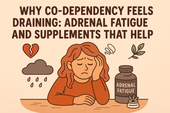
Why Co-Dependency Feels Draining: Adrenal Fatigue and Supplements That Help
The adrenal glands are small but powerful organs that sit above your kidneys, acting as your body’s built-in stress managers. They produce hormones like cortisol and adrenaline that help regulate energy, mood, and resilience. When they’re overworked from chronic stress or emotional exhaustion, fatigue and imbalance follow. Supporting adrenal health naturally can help restore calm, energy, and hormonal balance. 🌿⚡
-

The Link Between Anxiety, Co-Dependency, and Natural Support
Anxiety feels like living in constant alert mode—your heart races, your thoughts loop, and your body can’t find peace. It’s the nervous system’s way of preparing for danger, even when none exists. Understanding what’s happening in your mind and body is the first step toward calming the storm and restoring balance. 🌿💫
-
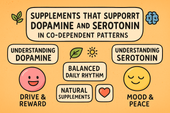
Supplements That Support Dopamine and Serotonin in Co-Dependent Patterns
Serotonin is the neurotransmitter of calm, confidence, and contentment. When it’s balanced, you feel peaceful and emotionally grounded. When it’s low, anxiety, mood swings, and emotional dependence take over. By understanding serotonin’s role in emotional health—and how to support it naturally—you can rebuild inner stability, improve relationships, and cultivate lasting happiness from within. 🌞💫
-

How Emotional Exhaustion in Codependency Impacts the Nervous System
The nervous system is the body’s communication network, connecting the brain to every organ and muscle. It regulates stress, mood, and emotion through a delicate balance of electrical and chemical signals. When overwhelmed, it can become dysregulated—leading to fatigue, anxiety, and emotional imbalance. Understanding how to calm and strengthen the nervous system is key to healing from chronic stress and emotional burnout. ⚡🌿
-
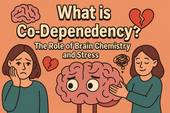
What Is Co-Dependency? The Role of Brain Chemistry and Stress
Stress is more than a feeling—it’s a full-body experience that begins in the brain and ripples through every cell. When cortisol surges and the nervous system stays on alert, your body can’t rest or recover. Over time, this constant tension affects energy, focus, mood, and even immune health. Understanding stress chemistry is the first step toward breaking free from burnout and finding calm again. 🌿
-

Creating a Supplement Stack for Motivation, Energy, and Anti-Procrastination
Motivation is the fuel behind every meaningful achievement—but it’s not just about willpower. It’s a mix of mindset, brain chemistry, and momentum. When energy, focus, and purpose align, action feels natural instead of forced. Learn how to harness motivation as a daily state, not a fleeting feeling.
-

Supplements for Building Consistency and Reducing Chronic Procrastination
Biochemistry is the bridge between biology and chemistry—the science of life at the molecular level. It explains how nutrients, hormones, and neurotransmitters interact to create energy, thought, and emotion. From brain function to muscle movement, biochemistry reveals the invisible processes that sustain health, balance, and vitality.
-
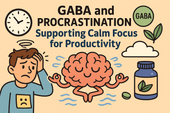
GABA and Procrastination: Supporting Calm Focus for Productivity
GABA is the brain’s natural calming messenger—a neurotransmitter that helps slow mental overactivity and ease stress. When GABA levels drop, focus fades, anxiety rises, and procrastination becomes more likely. By supporting GABA through nutrition, lifestyle, and supplements, you can restore calm clarity, improve focus, and take action with steady, balanced energy.
-
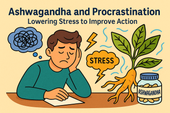
Ashwagandha and Procrastination: Lowering Stress to Improve Action
Science is the language of curiosity and discovery. It helps us understand the hidden patterns behind life, energy, and the universe. Through experimentation and critical thinking, science connects imagination to evidence—turning questions into knowledge. Whether through microscopes, molecules, or minds at work, science represents our endless pursuit of truth and innovation.
-

Neurotransmitters and Motivation: Supplements That Support Drive and Focus
Supplements can do more than boost physical health—they can also enhance mental clarity, focus, and motivation. Nutrients like omega-3s, magnesium, B vitamins, and adaptogens help balance neurotransmitters, stabilize mood, and support brain energy. When combined with good sleep, nutrition, and mindful habits, they can transform how your brain performs under stress.
-

How Stress Hormones Like Cortisol Fuel Procrastination (and What Helps)
Blood sugar isn’t just about physical health—it directly impacts focus, mood, and motivation. When glucose levels spike and crash, energy and attention do the same, fueling procrastination and brain fog. Learning how to stabilize blood sugar through balanced meals, mindful habits, and key nutrients helps keep your mind steady, focused, and ready to act.
-
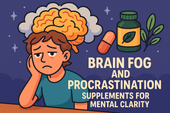
Brain Fog and Procrastination: Supplements for Mental Clarity
Brain fog can turn even simple tasks into mental hurdles. When your thoughts feel slow and unclear, procrastination often follows—making focus and productivity seem impossible. This article explores the biochemical and lifestyle causes of brain fog and reveals the most effective supplements for restoring mental clarity, focus, and sustained energy.
-

The Link Between Low Energy and Procrastination: Can Supplements Help?
Neurochemistry shapes how we think, feel, and act. When neurotransmitters like dopamine, serotonin, and GABA fall out of balance, it can lead to fatigue, anxiety, or lack of motivation—fueling procrastination and low mood. Understanding the brain’s chemical communication system helps us find ways to restore focus, calm, and emotional stability through nutrition, mindfulness, and targeted supplements.
-
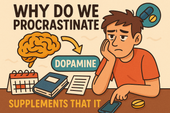
Why Do We Procrastinate? The Role of Dopamine and Supplements That Support It
Dopamine is the brain’s motivation messenger—the chemical that fuels focus, reward, and drive. When dopamine levels drop, even simple tasks can feel impossible to start. This article explores how dopamine shapes procrastination, motivation, and mental energy, along with natural supplements and daily habits that help restore balance and get things done.
-
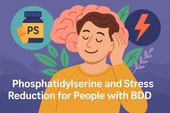
Phosphatidylserine and Stress Reduction for People with BDD
Stress is more than a mental state—it’s a full-body experience that affects hormones, brain chemistry, and emotional balance. For people with Body Dysmorphic Disorder (BDD), constant tension and worry about appearance can overload the nervous system. Learning how stress works and finding ways to calm it is key to breaking the cycle of anxiety and self-criticism.
-

How Antioxidants Like Vitamin C & E Support Mental Health in BDD
Antioxidants are the body’s natural defense against stress and inflammation. For people with Body Dysmorphic Disorder (BDD), oxidative stress can worsen fatigue, anxiety, and emotional imbalance. Nutrients like Vitamin C and E help protect brain cells, boost neurotransmitter function, and support a calmer, clearer mindset—building a stronger foundation for recovery.
-
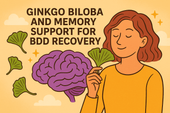
Ginkgo Biloba and Memory Support for BDD Recovery
Emotional regulation is the foundation of healing from Body Dysmorphic Disorder (BDD). When the nervous system stays in constant overdrive, even small stressors can trigger self-critical spirals. Learning to calm emotional reactivity helps restore clarity, confidence, and a sense of inner balance. By blending mindfulness, nervous system support, and self-compassion, you can retrain your brain to respond—not react—to emotion.
-
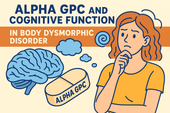
Alpha GPC and Cognitive Function in Body Dysmorphic Disorder
Mental fatigue can feel like your brain has hit a wall—thoughts slow down, focus fades, and motivation disappears. For people with Body Dysmorphic Disorder (BDD), chronic overthinking, emotional stress, and constant self-evaluation can deplete mental energy even further. Understanding what causes this cognitive exhaustion is the first step toward recovery—through rest, balanced nutrition, and targeted brain-supporting supplements.
-
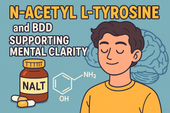
N-Acetyl L-Tyrosine and BDD: Supporting Mental Clarity
Chronic stress doesn’t just affect your mood—it reshapes your brain chemistry, weakens focus, and fuels the obsessive thought loops common in Body Dysmorphic Disorder (BDD). Over time, constant cortisol elevation drains mental energy and emotional balance. Learning to recognize and manage chronic stress is essential to restoring mental clarity, self-compassion, and resilience.
-

Chamomile and Lavender for Calming Obsessive Body Image Thoughts
The nervous system is the command center of our emotional and physical world—and in Body Dysmorphic Disorder (BDD), it often operates in overdrive. Understanding how the brain and body communicate under stress reveals why intrusive thoughts feel uncontrollable. Learning to regulate the nervous system through calm practices, nutrition, and supplements helps restore inner balance and emotional safety.
-
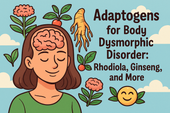
Adaptogens for Body Dysmorphic Disorder: Rhodiola, Ginseng, and More
Rhodiola rosea, often called the “golden root,” is an adaptogenic herb renowned for boosting stress resilience and mental endurance. For individuals with Body Dysmorphic Disorder (BDD), Rhodiola may help reduce fatigue, regulate cortisol, and enhance emotional balance. By supporting both mind and body, this powerful plant promotes calm focus, improved mood, and renewed energy to face daily challenges.
-

B Vitamins for Stress Resilience in BDD: Rebuilding Calm from Within
Biochemistry is at the heart of every thought, emotion, and reaction we experience. In Body Dysmorphic Disorder (BDD), chemical imbalances in neurotransmitters like serotonin, dopamine, and GABA can amplify stress and distort self-perception. Understanding the biochemistry behind mood and stress regulation offers a path toward healing—bridging the gap between emotional experience and the body’s molecular balance.
-
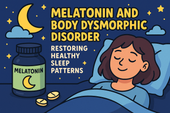
Melatonin and Body Dysmorphic Disorder: Restoring Healthy Sleep Patterns
Melatonin, the body’s natural sleep hormone, plays a vital role in helping people with Body Dysmorphic Disorder (BDD) restore healthy sleep cycles. When anxiety and obsessive thinking interfere with rest, melatonin levels often drop, leading to more emotional reactivity and distorted self-perception. This article explores how melatonin works, why BDD disrupts it, and how natural supplementation—combined with mindful routines—can help the brain and body finally find calm at night.
-
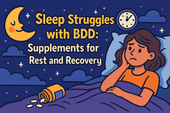
Sleep Struggles with BDD: Supplements for Rest and Recovery
When you’re living with Body Dysmorphic Disorder (BDD), restful sleep can feel impossible—but the right supplements can help reset your body’s natural rhythm. From magnesium and L-theanine to 5-HTP and ashwagandha, these nutrients support relaxation, lower cortisol, and enhance melatonin production. This article explores how supplements can calm the mind, ease nighttime anxiety, and promote true restorative sleep for emotional and physical recovery.
-
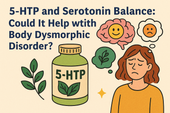
5-HTP and Serotonin Balance: Could It Help with Body Dysmorphic Disorder?
Anxiety can feel like a storm inside the mind—restless, overwhelming, and hard to control. In people with Body Dysmorphic Disorder (BDD), anxiety often fuels obsessive thoughts and self-criticism, creating a painful cycle of worry and self-doubt. This article explores the biological roots of anxiety, the role of neurotransmitters like serotonin and GABA, and how natural strategies such as mindfulness, supplements, and nervous system regulation can restore calm and mental clarity.
-
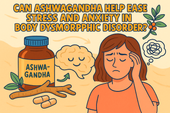
Can Ashwagandha Help Ease Stress and Anxiety in Body Dysmorphic Disorder?
Neurotransmitters like serotonin, dopamine, GABA, and acetylcholine are the chemical messengers that shape how we think, feel, and react to stress. In Body Dysmorphic Disorder (BDD), imbalances in these neurotransmitters can amplify anxiety, obsessive thinking, and emotional distress. This article explores how restoring healthy brain chemistry through nutrition, supplements, and mindfulness can help bring clarity, calm, and emotional stability.
-
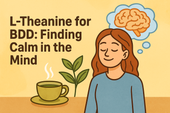
L-Theanine for BDD: Finding Calm in the Mind
Neurochemistry plays a central role in how we think, feel, and see ourselves. For those living with Body Dysmorphic Disorder (BDD), imbalances in neurotransmitters like serotonin, dopamine, and GABA can intensify anxiety, obsessive thoughts, and emotional distress. This article explores how regulating brain chemistry through supplements, mindfulness, and lifestyle changes can bring the nervous system back into harmony and restore inner calm.
-

Omega-3 Fatty Acids and Body Image Disorders: Supporting Emotional Health
Omega-3 fatty acids do far more than support heart health—they nourish the brain, stabilize mood, and may ease the emotional turbulence tied to body image disorders like BDD. This in-depth article explores how omega-3s regulate serotonin, dopamine, and inflammation, helping individuals reduce obsessive thoughts and rebuild self-acceptance. It also connects nutrition to therapy, mindfulness, and nervous system balance for holistic emotional healing.
-
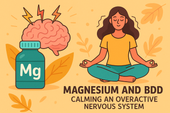
Magnesium and BDD: Calming an Overactive Nervous System
Magnesium plays a crucial role in calming an overactive nervous system—something people with Body Dysmorphic Disorder (BDD) struggle with daily. This article explores how magnesium supports relaxation, emotional regulation, and stress reduction while diving into the science behind its connection to brain chemistry. It also examines how combining magnesium supplementation with therapy and breathwork can help rebalance the body’s stress response, reduce obsessive thought patterns, and promote lasting nervous system calm.
-
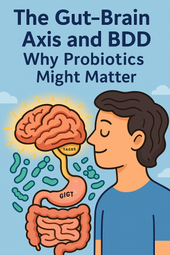
The Gut-Brain Axis and BDD: Why Probiotics Might Matter
The gut and brain are constantly in conversation — and that dialogue may shape how you experience Body Dysmorphic Disorder. By nurturing your microbiome with probiotics, prebiotics, and gut-healing nutrients, you can help rebalance serotonin, calm anxiety, and restore emotional stability from within 🧠🦠.
-
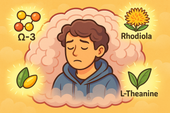
Brain Fog and Body Dysmorphic Disorder: Can Nootropic Supplements Help?
Brain fog often accompanies Body Dysmorphic Disorder, clouding focus and deepening emotional fatigue. Nootropic supplements like L-theanine, Rhodiola, and CoQ10 can help restore mental clarity, balance neurotransmitters, and bring calm energy back to the mind 🌿🧠.
-
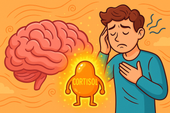
How Stress Hormones Like Cortisol May Worsen Body Dysmorphic Disorder
Chronic stress floods the brain with cortisol — the hormone that keeps you on high alert. In Body Dysmorphic Disorder, this chemical overdrive fuels anxiety, distorts self-image, and traps the body in survival mode. Calming cortisol helps restore both peace and perspective 🌿🧠.
-
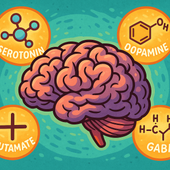
The Role of Neurotransmitters in BDD—and How Supplements May Help
Neurotransmitters like serotonin, dopamine, glutamate, and GABA shape how people with Body Dysmorphic Disorder perceive themselves. When these brain messengers fall out of balance, perception distorts — but targeted supplements can help restore calm, focus, and emotional regulation 🧠🌿.
-

Keeping Calm in Competitive Sports: How to Train Your Mind, Body, and Chemistry for Peak Performance
Competitive pressure can overwhelm even the strongest athletes — but calm is trainable. By combining supplements like magnesium, L-theanine, and adaptogens with breathwork and mindset training, you can stay focused, balanced, and in control under any level of stress 🧠🏅.
-

Supplements for Parents Facing Toddler Tantrums: Staying Calm When Little Emotions Run Wild
Toddler tantrums can drain even the most loving parent — but your calm is powerful. With the right supplements like magnesium, L-theanine, and ashwagandha supporting your nervous system, you can stay patient, grounded, and kind, even when emotions run high 🧸🌿.
-

Workplace Stress and Anger Management Support
Workplace stress can quickly turn into frustration — but calm is a skill you can train. By combining supplements like magnesium, L-theanine, and adaptogens with breathwork and mindset tools, you can stay focused, patient, and emotionally grounded no matter how intense the office gets 💼🌿.
-

How to Stay Patient With Family During Stressful Holidays
Holiday gatherings can stir up old stress and test your patience — but calm is possible. With nervous system support from magnesium, L-theanine, and adaptogens, plus mindful breathing and clear boundaries, you can stay centered, kind, and grounded even when family chaos unfolds 🎄💞.
-

Supplements to Keep Calm During Traffic Jams
Getting stuck in traffic doesn’t have to ruin your mood. With calming supplements like magnesium, L-theanine, and ashwagandha, you can train your body to stay relaxed and focused behind the wheel — turning gridlock into a moment of grounded patience 🚗🌿.
-
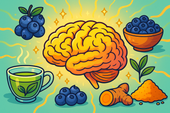
The Role of Antioxidants in Healing Brain Stress from Dissociation
Antioxidants protect the brain from the oxidative stress caused by trauma and dissociation. By neutralizing free radicals and supporting mitochondrial recovery, they help restore clarity, focus, and emotional balance — allowing the mind to heal at the cellular level 🌿🧠.
-
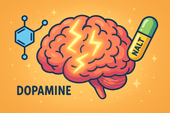
N-Acetyl L-Tyrosine (NALT) for Supporting Mental Clarity
N-Acetyl L-Tyrosine (NALT) fuels dopamine production — the neurotransmitter of focus and motivation. By supporting brain chemistry during stress, NALT helps restore mental clarity, energy, and alertness, making it easier to think clearly and feel present again ⚡🧠.
-

How Ginseng May Improve Focus and Energy in Dissociation
Ginseng helps combat the mental fatigue and fog that often come with dissociation. By supporting mitochondrial energy, balancing neurotransmitters, and regulating cortisol, it gently restores focus, motivation, and emotional presence — helping the mind reconnect with clarity and strength 🌿⚡.
-
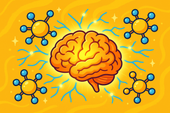
Phosphatidylserine and Dissociation: Supporting Cognitive Function
Phosphatidylserine helps calm the stress response by balancing cortisol, the body’s primary stress hormone. By lowering cortisol spikes, it protects memory, focus, and emotional stability — restoring clarity and mental presence for those struggling with dissociation 🧠🌿.
-
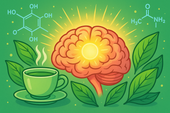
Can Green Tea Extract Help with Dissociative Brain Fog?
Green tea extract may help lift dissociative brain fog by supporting neurotransmitter balance, reducing inflammation, and enhancing energy at the cellular level. With its key compounds EGCG and L-theanine, it promotes calm focus, clarity, and emotional presence — helping you feel more alert and grounded 🍵🧠.
-
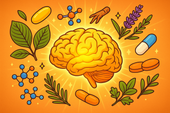
Building a Natural Supplement Stack for Dissociation Support
Building a supplement stack for dissociation means nourishing the brain and body back into communication. By supporting neurotransmitters, gut health, and energy balance through nutrients like magnesium, omega-3s, curcumin, and probiotics, you can help restore clarity, calm, and connection — one layer at a time 🌿🧠.
-

Chamomile and Lavender for Dissociative Anxiety Relief
Chamomile and lavender work together to calm dissociative anxiety by soothing the nervous system and restoring emotional safety. Their natural compounds balance cortisol, enhance GABA activity, and activate the vagus nerve — helping you feel grounded, connected, and at peace again 🌿💜.
-
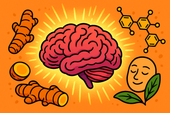
Curcumin for Inflammation and Mental Clarity in Dissociation
Curcumin, the golden compound in turmeric, does more than fight inflammation — it helps clear the mental fog often tied to dissociation. By calming neuroinflammation, balancing neurotransmitters, and supporting mitochondrial energy, curcumin can restore mental clarity, focus, and emotional presence 🌿🧠.
-
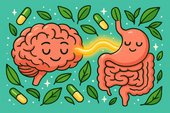
Probiotics and Dissociation: Exploring the Gut–Brain Axis
The gut–brain axis plays a vital role in emotional awareness and presence. When the microbiome is balanced, it supports serotonin production, vagus nerve activity, and calm focus. Probiotics help repair this connection — restoring safety, clarity, and the feeling of truly being in your body again 🌿🧠.
-
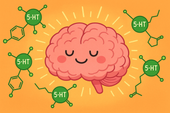
5-HTP for Dissociation: Supporting Serotonin and Emotional Stability
5-HTP helps bridge the gap between emotional numbness and stability by supporting serotonin production — the neurotransmitter that shapes mood, sleep, and sensory awareness. For people experiencing dissociation, 5-HTP may gently restore connection, presence, and emotional balance from the inside out 🌿🧠.

















































